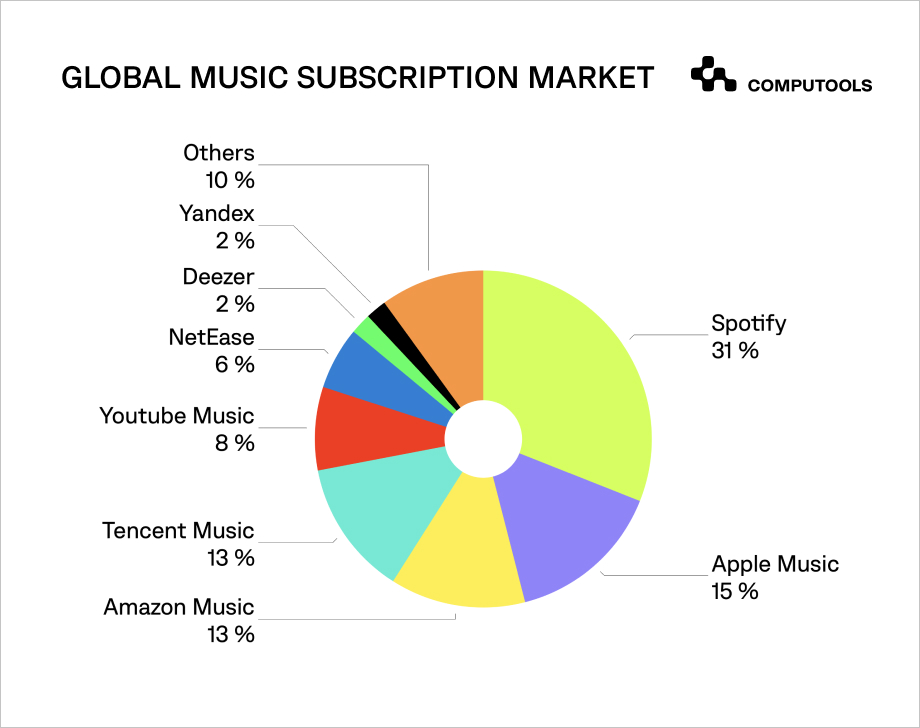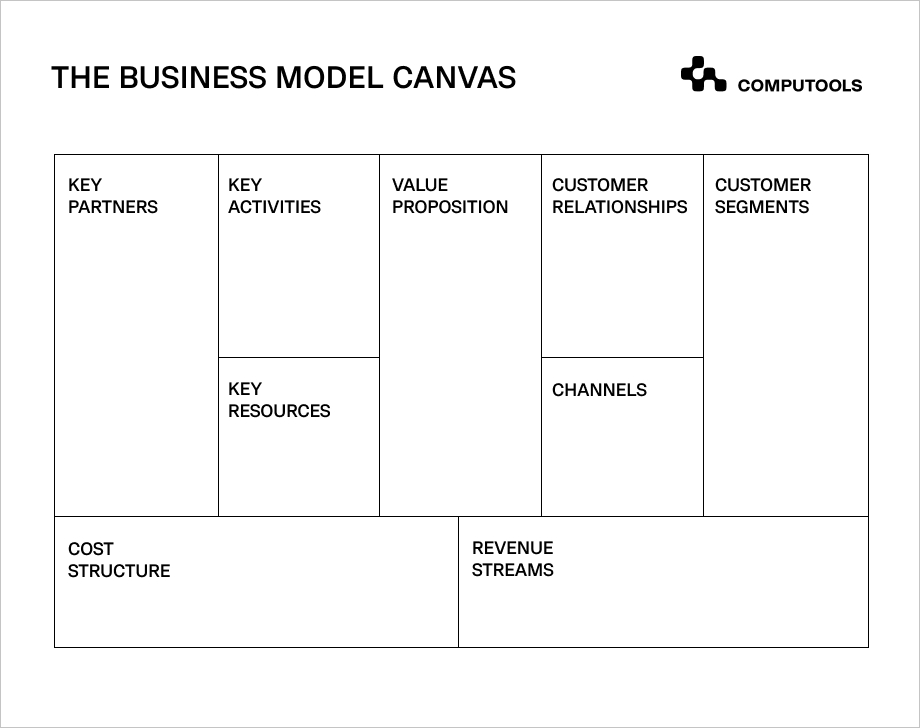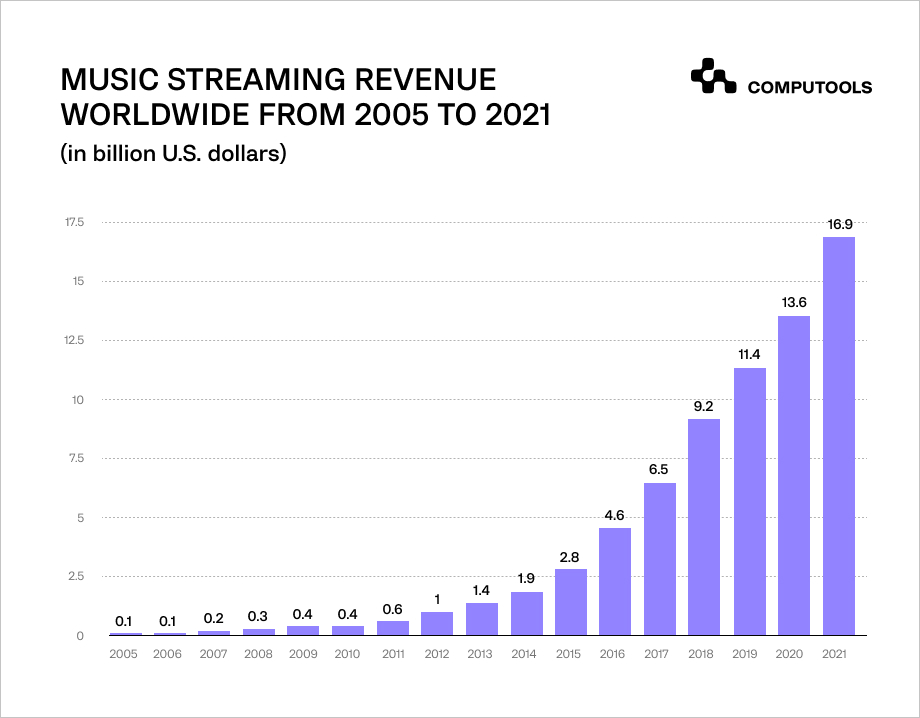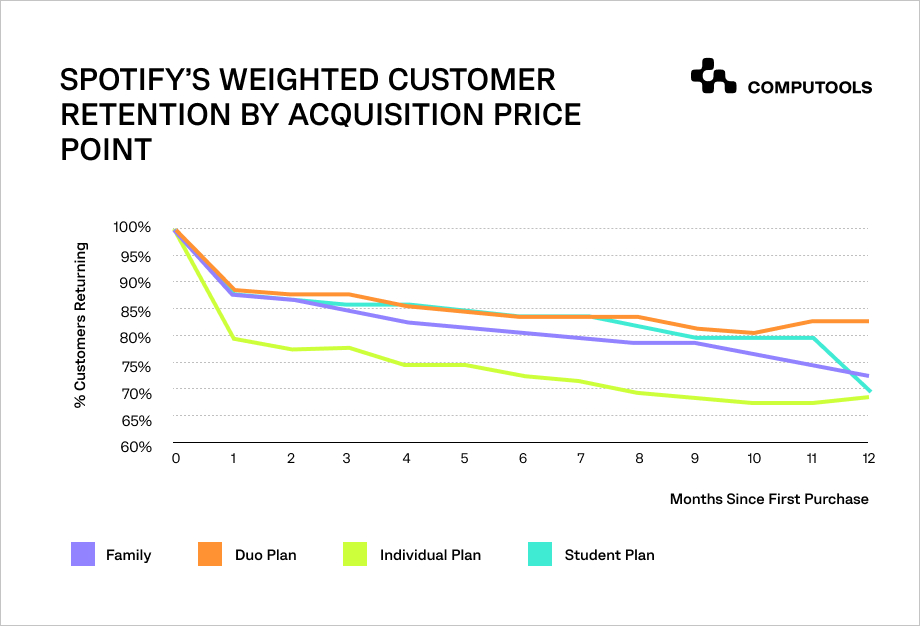In the past ten years, music streaming apps have revolutionized. It’s expected that by 2023, the music streaming market will grow to $10 billion. As new players enter a competitive market, the differentiators bringing value that the big names aren’t are sweeping up niche users.
In this article, we’ll discuss the benefits of music app development and how to make a music app like Spotify.
How do streaming services work
Music streaming services are mobile or web-based applications built on iOS or Android. They work like any software-as-a-service solution, where data is stored on cloud-based servers.
From a business perspective, music streaming providers buy a license from labels, publishers, artists, and others to stream music on their platforms.
Spotify, for example, spends about 70% of its revenue on royalty payments. In 2021 alone, Spotify spent $7 billion in royalties.
In Spotify’s case, they use a very complex algorithm to determine the royalties for streaming that should be paid to artists. As a result, only some rights holders and artists get the same royalties. It depends on the contracts, the country where songs are produced, and currency value. According to Verve, the average “per stream” payment to rights holders is between $0.006 and $0.0084.
Other spending revolves around content acquisition, company acquisitions, employee compensation, facilities, product research and development, and maintenance.
Spotify and other popular streaming services make money from paid subscriptions (premium, family, student) and advertisements.
Premium subscriptions are the main source of income. They remove ads and download restrictions and increase song bitrate to 320 kbps.
As for ads, Spotify supports ad playlists, branded moments, sessions, audio, video captures, home page captures, overlays, advertiser pages, and branded playlists. These ads vary in type, size, and user engagement.
How to add extra value to a music streaming app
The business model of the first music streaming services was simple. There were almost no competitors, and with advertising and convenient subscriptions, it was possible to increase profits.
Today’s climate with giants like Spotify, Apple Music, Google Play Music, Amazon Music, Deezer, Soundcloud, and other major platforms is different story.

To harness the true benefits of music streaming app development, it’s important to follow essential blocks of the business model canvas beforehand. These sections should connect customers and products and go hand in hand with the company’s product or service.

For example, Spotify’s business canvas looks like this:
• Customer segment: Music aficionados, artists, advertisers
• Value proposition: Access to a vast pool of music on a subscription basis at a low cost
• Channels: mobile, web, and desktop application
• Customer relationship: major social media networks like Facebook and Twitter
• Key resources: 80 million tracks and around 4 million podcasts
• Key activities: processes that help increase value and to stay in business (content acquisition, finance negotiation, platform maintenance, marketing activities)
• Key partnerships: advertisers, artists, music labels
• Revenue streams: advertisements and premium subscriptions
• Costs: royalties, debt maintenance, research and development, maintenance, employee compensations, etc.
Startups trying to penetrate the market have more chances to succeed by offering unique value propositions and focusing on a particular target audience, as well as providing more personalized design and marketing.
During music streaming app development, businesses can prioritize different music genres, countries, or regions and include functionality that helps young artists promote a personal brand, organize tours, and accept donations.
This can be a great value proposition considering the poor support of artists from major music streaming apps.
By providing more functionality to the app and focusing on a specific target audience, the business will have a much better chance of success.
Despite the competition, developing an app that will compete with Spotify is possible.

Computools
Software Solutions
Computools is an IT consulting and software engineering company that delivers innovative solutions to help businesses unlock tomorrow. Our clients represent a wide range of industries, including retail, logistics, finance, healthcare, and others.
Benefits of developing a music streaming app
Investing in music app development can provide new businesses with the following benefits.
1. Great opportunities for monetization
As streaming services play a major role in the music industry’s landscape, the revenues and number of users also grow. Streaming revenues have hit a whopping $16 billion, with almost 80 million paying subscribers in the US alone.

Additionally, music streaming platforms earn approximately $20 per user.
Therefore, music streaming platforms can profit with the right monetization strategy.
Some of the main monetization strategies for music apps like Spotify are:
• Paid subscription (Individual, Duo, family, student)
• Advertisement
• Freemium model
2. Scalability
Despite the established market, nothing is set in stone in the digital world: there are many opportunities to add new features and services with music app development. Think of different business models and added value that you can offer to your target audience.
3. High customer retention rates
Music streaming apps show good customer retention rates. With the various subscription plans, users utilize applications in the best way that suits them, which adds to brand loyalty and usage rates.
For example, here is an avid comparison of the “duo” plan to other plans. It has the highest retention rates over 12 month period.

4. More available technologies
As such technologies as AI, Big Data, and Cloud become more available, businesses have more opportunities to adopt them cost-effectively in the future. Besides, these technologies show measurable results on medium and long distances. Therefore, the earlier companies implement them, the better.
AI and Big Data technologies have become irreplaceable tools during music streaming app development. The way streaming platforms process customer data will define the success of the app.
For example, with these technologies on board, Spotify managed to attract 40 million users to their “Discover Weekly” playlist back in 2016, while other implicit data allows them to tailor and add new beneficial features in the future.
Wrapping up
Recent research on music streaming competition shows that there’s manageable competition and the biggest challenge is artist support and benefits.
Most streaming platforms like Spotify favor mainstream international music produced by major labels while undersupporting independent and niche music.
Thus, developing more locally-focused streaming apps with the right technologies can bring substantial benefits and profits for those who try to penetrate the market.
If you are not sure where to start and seek advice or consultation on how to make a music app, feel free to contact our experts in the media and entertainment industry at info@computools.com.









“Computools was selected through an RFP process. They were shortlisted and selected from between 5 other suppliers. Computools has worked thoroughly and timely to solve all security issues and launch as agreed. Their expertise is impressive.”